Daphne du Maurier and Alfred Hitchcock
1 March, 2013
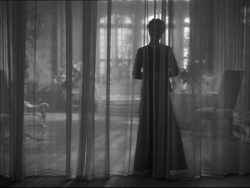
I was tempted to sub-title this talk ‘The Mistress of Romance meets The Master of Suspense’, except that there’s more to Daphne du Maurier than Romance and more to Alfred Hitchcock than Suspense. Actually, to the best of my knowledge, they never did meet, certainly not socially, and there are slightly unusual aspects to this. For example, Hitchcock was actually a friend of Daphne’s father, Sir Gerald du Maurier, who appeared in one of his films, Waltzes from Vienna(1933) and whom Hitchcock described to François Truffaut as ‘in my opinion, the best actor anywhere’. He did want to make a film of one of the Bulldog Drummond stories with Gerald du Maurier; and it is sometimes said that the main character of one of Hitchcock’s early talkies, Murder (1930) – about a distinguished actor who is on a jury that finds a young woman guilty of murder but who then begins to suspect that there may have been a miscarriage of justice – was actually modelled on Gerald du Maurier. (The part is played in the film by Herbert Marshall.) Both of them, incidentally, were great practical jokers and Hitchcock’s most successful one played on Sir Gerald was an occasion when he invited him to a fancy dress party. Sir Gerald turned up in greasepaint and wearing a kilt, only to discover that it was a formal black tie and tails affair, and he had to bid a hasty retreat.
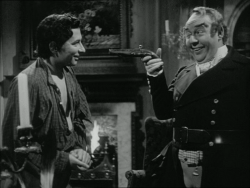
The fact that Hitchcock knew father Sir Gerald much better than daughter Daphne is also striking because Hitchcock was to adapt three of Daphne du Maurier’s works for the screen. Of the 50-odd feature films Hitchcock made, most of which are adaptations of novels, short stories or plays, there is no other writer I can think of offhand whom Hitchcock adapts more than once, and yet there are three du Maurier adaptations. One of them, Jamaica Inn, which was the last film he made in England before his departure to America in 1939, is self-confessedly one of his lesser works. Hitchcock himself described it as ‘an absurd thing to undertake’, and one of the best critics of Hitchcock’s English period, Charles Barr has said that ‘it is almost alone among Hitchcock’s films in containing no felicitous scene or line or detail that gets remembered and quoted, or that deserves to be’. The other two, however, Rebecca(1940) and The Birds (1963) are two of Hitchcock’s most important films, and two particularly fascinating examples of du Maurier adaptations for the screen, because they could not be further apart: one, a novel, the other a short story, so one requires compression whilst the other requires expansion; and one that sticks fairly close to the original text, whereas the other departs almost completely from the original apart from retaining the basic situation. Not surprising perhaps that the author herself was said to be delighted with the first and horrified by the second.
Still, it does prompt the question: what was it about Daphne du Maurier’s work that stimulated Hitchcock’s interest and encouraged him to adapt her more than any other author? I think there were two things that Hitchcock particularly responded to:
The thing he seems to have admired most in writers is what one might call good craftsmanship, a fascinating story well told within a solid structure. He wasn’t a fan of florid writing, of a literary style that drew attention to itself, or of modernist experimentation, or of Art for Art’s Sake. This, I think, derives from his theatre-going as a young man around the early 1920s where he was a great admirer of the so-called well-made play, the kind of literature that unobtrusively held your attention and where all the parts were seen to fit together. (Hitchcock’s admiration for John Russell Taylor’s book on the subject of the well-made play is thought to have encouraged him to invite Taylor to write his authorised biography.) There might be a lot of subtler things going on under the surface in these plays, but these could be uncovered later. The immediate thing is that your attention is held by a good yarn and interesting characters. I think he saw Daphne du Maurier in that same tradition of writers like John Buchan, Marie Belloc Lowndes, J.M. Barrie, J.B. Priestley, John Galsworthy: i.e. writers who tended to become unfashionable in the middle of the last century and to be downgraded in academic circles for being middlebrow, conventional, technically unadventurous etc, but who wrote accessibly, entertainingly and successfully for a mass readership.
The second thing that might have attracted him is something that du Maurier says in her introduction to one of her short story anthologies: ‘I’ve always been fascinated by the unexplained, the darker side of life, the macabre.’ That would certainly appeal to a director who, when criticised for the illogicality of his plots, would reply, ‘I have a saying to myself: logic is dull’; and who once said, ‘I have brought murder back into the home, where it belongs’. He was certainly fascinated by the darker side of life, by the extremities of violent passion, and, according to some biographers, he had his own dark side, so there’s definitely a kinship between the two there.
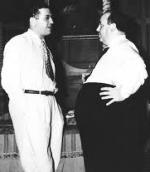
So: to move onto Rebecca, Daphne du Maurier’s novel, which had been published to huge popular success in 1938 and I believe has never been out of print since. It was Hitchcock’s first American film (a bit ironic, this, since it was a very British subject, and most of the main cast were British) and produced by the mercurial mogul, David Selznick, who had just had a colossal success with Gone with the Wind. He was the man who had lured Hitchcock to America and put him under contract; and, for a while, they had discussed making a film about the Titanic before fixing on Rebecca for their first collaboration. Immediately conflict arose. Hitchcock wanted to open out the novel a bit and also introduce a lot more comedy. He invariably felt a bit uneasy if he couldn’t inject some humour into his material: even when he came to make Psycho, he thought of it as a fun film. Selznick was horrified by what he was proposing and insisted that they stick to the story, because that was what lovers of the novel would expect and would pay to see. Over and above that conflict of approach, there was inevitably the usual adaptation problem of how you condense a 400 page novel into a two hour film. As David Lean said when discussing his classic film adaptations of Dickens, Great Expectations and Oliver Twist: ‘The thing not to do is try a put a little bit of every scene of the novel into your film, because it’s going to end up a mess. Choose what you want to do in the novel, and do it proud.’ The challenge remains the same: how to turn words, even thoughts, into images. But, of course, what you choose to include- and exclude- will be very revealing not simply about how you are, as it were, illustrating the novel but how you are interpreting it. There was another important issue with regard to the adaptation of Rebecca for the screen, and that was the issue of censorship. The hero might have been allowed to get away with murder in the novel, but, given the Hollywood Production Code at the time, this was certainly not permissible in the film so the adaptation had to contrive another set of circumstances whereby Maxim could plausibly feel a sense of guilt over Rebecca’s death without actually having killed her.
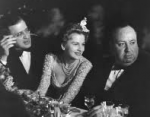
In a moment I want to discuss an extract from the film but just to set the context for you. Many of you will know the plot of Rebecca at least as well as I do, but there are some differences from the novel in the film. A young unnamed heroine (played in the film by Joan Fontaine) is accompanying her employer, Mrs Van Hopper (Florence Bates) as a paid companion on holiday in Monte Carlo. She meets the mysterious Maxim de Winter (Laurence Olivier), who in the film we first meet standing perilously close to the edge of a cliff, staring down into the sea below, and looking for all the world as if he’s about to jump: the young woman cries out to him in alarm and breaks the spell. We learn that he’s the owner of one of the grandest country houses in England, Manderley, and that he was married to Rebecca, who died in a boating accident a year before and whom, so they say, he adored. To the young woman’s astonishment- and we never do learn her name (when Hitchcock suggested calling her Daphne, Selznick was appalled)- Maxim begins paying her attention; and when it seems as if she might have to go to New York with her employer, he proposes marriage. She’s astounded- how can someone like him be interested in someone like her?- but accepts, of course, because by this time she’s madly in love with him.
When they arrive at Manderley, she’s completely overawed by her surroundings, seeming (and looking) a bit like a commoner in a palace surrounded by royalty. More than that, though, there are reminders of Rebecca everywhere- initialled pillowcases, stationery, monogrammed handkerchiefs etc.- and incessant talk of Rebecca’s brains, beauty, breeding, which only serve to make her feel even more insecure and inadequate and feel that Maxim only married her out of loneliness. Above all, the housekeeper, Mrs Danvers (Judith Anderson) seems to hate her, because she adored Rebecca and resents anyone taking her place. Just before we join the extract, the heroine has had a particularly upsetting encounter with Mrs Danvers who has shown her Rebecca’s room in the West Wing and all of Rebecca’s elegant clothes and ornaments in a way that underlines the heroine’s feelings of inadequacy and inferiority in such a setting. She has run out of the room, crying- but now decides it’s time to assert her authority and behave in the manner expected of the new Mrs de Winter, mistress of Manderley. What better way than to organise one of those grand costume balls that Manderley was famous for?
[Extract starts at 3:05]
[Extract starts at 3:05]
Just to make a few comments on the sequence of the Costume Ball, its preparation and its immediate aftermath:
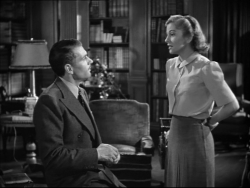
I like the little scene between the heroine and Maxim at the beginning, when she is asking his permission to hold the Ball. It captures in miniature their relationship: her adoration, his indulgent condescension; it could almost be father and daughter more than husband and wife and it’s certainly noticeable in the film that she talks a lot more about her father than her mother. Her childishness is emphasised by her gestures (obedient hands behind her back); and I’m always struck by the moment at the Costume Ball when Maxim’s sister, Beatrice (Gladys Cooper) arrives and she doesn’t say ‘Where’s so-and-so’ or ‘Where’s your wife?’ she says, ‘Where’s the child?’ And Maxim’s first suggestion of what she might go as is ‘Alice in Wonderland’. Her reply is, ‘I’ll give you the surprise of your life.’ Well, she certainly succeeds in that. Another line I really like in that scene happens when she says to Maxim, ‘I’ve been thinking…’ and he retorts: ‘What have you been doing that for?’ The implication is: no need for that sort of thing for a woman in this household, this society. Indeed, that was surely one of Rebecca’s problems. And might have been her undoing.
In the section where the heroine chooses the costume of one of Maxim’s ancestors, at the suggestion of Mrs Danvers, there are several interesting details:
a) the portrait that displays the costume dominates the shot, as if the heroine still is overwhelmed by what she has moved into, its glamour, its opulence, its grace;
b) the portrait is also the nearest we get to actually seeing Rebecca. It isn’t her, of course, but, as we’ll discover, the portrait features something that she’s worn. Hitchcock and Selznick did debate whether the film should show Rebecca in flashback (there was talk of Vivien Leigh playing the role) but I think they agreed eventually that part of the power of the character in the film is precisely that we never see her: we imagine her through other people’s descriptions of her beauty and brains and through visual details like the flourish of her signature. It’s an appeal to our imagination, but it’s more than that: it’s this feeling that the heroine is dealing with a ghost, a phantom, which makes it all the more difficult for her.
a) the portrait that displays the costume dominates the shot, as if the heroine still is overwhelmed by what she has moved into, its glamour, its opulence, its grace;
b) the portrait is also the nearest we get to actually seeing Rebecca. It isn’t her, of course, but, as we’ll discover, the portrait features something that she’s worn. Hitchcock and Selznick did debate whether the film should show Rebecca in flashback (there was talk of Vivien Leigh playing the role) but I think they agreed eventually that part of the power of the character in the film is precisely that we never see her: we imagine her through other people’s descriptions of her beauty and brains and through visual details like the flourish of her signature. It’s an appeal to our imagination, but it’s more than that: it’s this feeling that the heroine is dealing with a ghost, a phantom, which makes it all the more difficult for her.
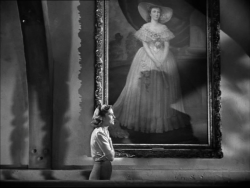
Then there’s Mrs Danvers, so superbly played by Judith Anderson. She’s the one who has set up this situation. She’s sinister not simply because she’s dressed in black, as if in permanent mourning for Rebecca, but she moves noiselessly, and in dead straight lines. The heroine is frightened of her partly because she often doesn’t hear her entrances, she’s suddenly there, making her jump. You’ll have noticed in this scene that she’s not aware that she’s gone: her silent exit is marked by a large dark shadow of her across the portrait, as if her malign influence is lingering on it; and the camera at that point closes in on the portrait as it seems to be looking at us, as if in possession of a great secret that we don’t as yet know.
The introduction to the Costume Ball does at least allow Hitchcock a bit of room for humour, with the brother-in-law (Nigel Bruce, probably most famous as the screen’s Dr Watson to Basil Rathbone’s Sherlock Holmes) as this strong man figure with a rubber weight; and Maxim’s estate manager, Frank (Reginald Denny) who, even in costume, looks hardly different from the boring practical man he is in everyday clothes.
The heroine’s approach is a very good example of Hitchcock’s use of subjective camerawork to approximate both the heroine’s point of view and the novel’s first-person narration: that is, he focuses his camera on the heroine, so that we empathise with her excitement and delight. When she passes the portrait, she looks at it fleetingly and, for the first time, you think, she feels she can stand comparison with Manderley magnificence rather than always feeling in its shadow. She’s found a new identity and when she comes down the stairs, we have the subjective use of the camera, as it were, reflecting her point of view as it moves towards the back of Maxim’s head to suggest the heroine’s approach and to prolong the sense of anticipation and suspense. How does Hitchcock get maximum dramatic power from what is to happen and from her excruciating embarrassment? I would suggest there are 3 things here:
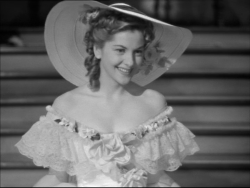
1) She’s smiling, anticipating Maxim’s approval, and that was very deliberate direction on Hitchcock’s part: the effect works better, he thought, ‘if you don’t put a dramatic expression into a face, but already have the face in a contrasting condition, say smiling. then, to get a reaction, you allow that smile to drain away from her face. The power comes not simply from the expression itself but from the contrast.’
2) The choreography: a waltz is playing in the background, and she seems to float down the stairs, almost in time to the music. But as she nears Maxim, the music stops, so that there’s this momentary sinking feeling, of anti-climax, and of course, the brief silence at that point seems to maximise the shock and embarrassment. Maxim’s anger can’t be covered up by the music and seems to resound even more resonantly as a result.
3) the use of close-up, which has been saved just for this moment to enlarge the sense of shock, embarrassment, horror.
Rebecca has often been seen as a sort of fairy-tale, but this is a dark variation: Cinderella arrives at the ball in her finest garments to see her Prince Charming, but his first reaction is to say, in so many words, ‘God, you look awful, get out of those clothes immediately, I don’t care what you put on.’ Olivier is particularly good here, pressing his hands to his temple as if his brain is about to explode; his flash of temper and the intensity of it certainly could suggest someone of a potentially murderous disposition.
The remainder of the sequence is particularly intriguing from an adaptation point of view, because Hitchcock and his screenwriters have very effectively telescoped two scenes from the novel into one and compressed the element of time. (They will do something similar in a later scene when they transfer Maxim’s confession about his hatred of Rebecca, which in the novel takes place in the library, to the boathouse where the ‘accident’ took place, which in turn allows Hitchcock to simulate a re-enactment of Maxim’s ‘crime’ through some cleverly suggestive camerawork.) Whereas in the novel she now goes back to her room, spends most of the night sobbing her eyes out and only confronts Mrs Danvers the next day, in the film the confrontation takes place immediately after the heroine’s humiliation, so that the mood is carried directly from one scene to the next. There’s an emotional continuity to the heroine’s despair, so that the moment when Mrs Danvers seems to be tempting her into committing suicide is one of hypnotic power. We have two figures in close proximity, one dressed in white, the other in black, almost like good and evil side by side, or like a snake hypnotising a rabbit. The close-ups and the music contribute to the feeling of romantic heartbreak and of wanting to end the agony; we are given the subjective shots of the mist into which the distraught heroine could temptingly disappear; the camera pulls away as if beckoning her to her doom, inviting her to let go- and then suddenly, the spell is broken by the explosion that signals a boat has run aground on the rocks.
All of that seems typical Hitchcock, so it’s a curious thing that he felt that Rebecca wasn’t really a Hitchcock picture. He felt constrained by having to follow the novel so closely, he felt a bit bullied by the producer, it wasn’t really his cup of tea, he would say. It was François Truffaut who pointed out to him very astutely that actually it was more characteristic and personal than he might have realised. ‘The novel itself was rather an unlikely one for you,’ Truffaut said to him. ‘It wasn’t a thriller: there was no suspense. It was simply a psychological story, into which you introduced the element of suspense around the conflict of personalities. The experience, I think, had repercussions on the films that came later.’ I think that’s spot on: the suspense in later Hitchcock will come as much from the psychology as from the situation. A number of his later films- like Vertigo (1958) andMarnie (1964), for example, and in the same way as Rebecca- only turn into murder mysteries two-thirds of the way through: before that the emphasis and suspense are all on the mystery of personality.
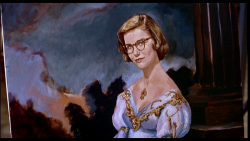
As in Rebecca, there are a number of later films in which the heroines have to measure themselves against an ideal of femininity. InVertigo, for example, there’s a scene not unlike the one we’ve just seen where a woman’s attempt to impress a man she loves by, as it were, ‘disguising’ herself as a feminine ideal she thinks he will admire goes disastrously wrong. (I am thinking of that almost unbearably painful scene when Midge does a parody portrait of herself as the beautiful Carlotta in an endeavour to shake Scottie out of his romantic trance and back into reality, but it only alienates and enrages him and underlines how deeply he is in the grip of obsession.) For all the director’s disclaimers about Rebecca, Hitchcock scholars, and particularly feminist critics, have seen all kinds of precursors of his future work: his empathy with the suffering heroine; the theme of romantic obsession; the overpowering house which is filled with the spirit of someone dead and which the heroine first approaches in pouring rain (that’s a bit like Marion Crane arriving at the Bates motel inPsycho); and a forerunner of what I think is Hitchcock’s greatest film, Vertigo, which also begins with its hero hovering over a precipice and also deals with an obsession with a dead woman and how the dead come back to haunt the living. Without consciously realising it, it seems, Hitchcock was responding to the material on quite a deep level, giving it a very personal slant. He’s offering an interpretation of the original which enlarges on and illuminates it in very interesting ways; and the material brings out something in him that was not at all apparent before he filmed Rebecca but was to become much more apparent afterwards: romantic anguish. So it’s one of those fascinating adaptations that brings something fresh to the novel and discloses something fresh about the director’s own artistic personality: a mutual enrichment.
I want now to move on to The Birds, which was released in 1963 and which was Hitchcock’s first film after his huge success with Psycho in 1960, so he was hoping to top that. Significantly, unlike in Rebecca, he didn’t have an interfering producer to contend with. By now he was his own producer and, to all intents and purposes, the star of the picture, internationally known through his cameo appearances in his films; through his hugely successful television series Alfred Hitchcock Presents which he always introduced and concluded himself; and through his complete identification with the genre of suspense thriller. He was the one director in the industry where you could sell a film on his name alone; and when you went to see an Alfred Hitchcock picture, you went with certain expectations of thrills and suspense. As he liked to put it, ‘If I made Cinderella, people would be looking for the body in the coach.’
So, when he came to make The Birds, he had much more freedom to do with the basic material what he wanted- for good or ill. Accordingly, he takes the basic situation, but he will put it in a completely different milieu with a completely different set of characters.
In a moment I will discuss a couple of extracts from the film as examples of the way Hitchcock creates suspense, but a word about Daphne du Maurier’s short story, which had first been published in 1952. ‘The idea for it,’ she said, ‘was born on my daily walks across the cliffs in Cornwall. I would see the farmer ploughing his fields, his tractor followed by a flock of gulls screaming and crying. As they dived for worms and insects, I thought, “Suppose they stop being interested in worms?”’ An example of her macabre imagination in action. Hitchcock had read the story when it first came out and indeed included it in one of those paperback anthologies Alfred Hitchcock Presents that featured short stories of a macabre or suspenseful nature. He claimed only to have read the story once and very quickly at that, so, unlike in Rebecca, there was to be no attempt at ‘fidelity’ to the original (though there are details from the story that will crop up in the film); and in these circumstances, it is interesting to consider why he turned to this story at this particular time or what attracted him to it. There is a lot of bird imagery in his previous film,Psycho: Norman Bates, with his stuffed birds on the wall seemingly watching him; even some the names in the film- Marion Crane, from Phoenix, Arizona- but Hitchcock said that was entirely coincidental. I think he felt the material offered the possibility of a new departure for him: it was experimental, enigmatic, technically challenging, even a bit arty in its lack of resolution.
The brief sequence I’m about to discuss is a bit gruesome, but this is Daphne du Maurier’s fault as much as Alfred Hitchcock’s, because the gruesome bit is a visual detail that is suggested in the original story. The setting now is not Cornwall but California, and the characterisation is not a farming community but consists of a socialite heroine, Melanie Daniels (Tippi Hedren) who, having met this lawyer, Mitch Brenner (Rod Taylor) in a bird shop in San Francisco when he’s buying a present of love birds for his younger sister, on a whim of romantic attraction decides to follow him to his home in Bodega Bay. She thus immediately incurs the hostility of the local schoolteacher, Annie Hayworth (Suzanne Pleshette), who is clearly in love with Mitch, and Mitch’s mother (Jessica Tandy), who seems to disapprove of Melanie and her life-style. Most significantly, as soon as Melanie arrives, the birds start behaving strangely. A gull swoops down and pecks Melanie on the forehead; a bird crashes into Annie’s front door; a flock of birds disrupt a children’s party, flying around, knocking things over, bursting balloons; and then a flock of sparrows comes down the chimney in the Brenners’ dining room and fly around, smashing teacups and china. What’s going on? The next morning Mitch’s mother goes to visit a friend, a local farmer, Dan Fawcett. She’s having some problems with some feed for her animals and needs some advice. She will find that the birds have got there before her:
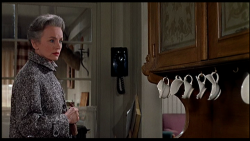
The gruesome detail of the farmer with his eyes pecked out is suggested in the original story: Hitchcock might have remembered more of it than he thought. Another moment that’s always interested me about that sequence is just a point about Hitchcock’s direction. Apparently, when they were filming it, Hitchcock suddenly felt there was something not quite right about the scene as it was written. When Lydia says ‘Dan, Dan, are you home?’ and there’s no answer, why didn’t she just leave? Hitchcock felt that he had to come up with something visual that would be unnerving enough to sustain the mood of tension, but not so frightening that she would leave anyway. So when she receives no answer to her call, she’s looking around and her eyes light upon something very strange, almost unaccountable: a row of cups hanging by their handles on the hooks by the sink, and the cups all broken, as if something has just flown along them in a destructive sweep. In the previous scene, the mother has been associated with china, trying to piece it together after the bird attack in their dining room (like her, it’s outwardly elegant but also brittle, and the metaphorical association between her and broken china seems to be hinting at her imminent breakdown). The image of the broken cups is just enough visually to tweak her interest into going further, but maintain the level of suspense, anxiety and apprehension: what is she going to find? I love that moment: it is a classic example of Hitchcock finding a visual solution to a dramatic and structural problem. To convey her distress and agitation, he even took care over the truck she drives away in and the dust that follows it: he wanted to suggest an anxious truck, an angry truck to keep up the emotional intensity.

The gruesome detail of the farmer with his eyes pecked out is suggested in the original story: Hitchcock might have remembered more of it than he thought. Another moment that’s always interested me about that sequence is just a point about Hitchcock’s direction. Apparently, when they were filming it, Hitchcock suddenly felt there was something not quite right about the scene as it was written. When Lydia says ‘Dan, Dan, are you home?’ and there’s no answer, why didn’t she just leave? Hitchcock felt that he had to come up with something visual that would be unnerving enough to sustain the mood of tension, but not so frightening that she would leave anyway. So when she receives no answer to her call, she’s looking around and her eyes light upon something very strange, almost unaccountable: a row of cups hanging by their handles on the hooks by the sink, and the cups all broken, as if something has just flown along them in a destructive sweep. In the previous scene, the mother has been associated with china, trying to piece it together after the bird attack in their dining room (like her, it’s outwardly elegant but also brittle, and the metaphorical association between her and broken china seems to be hinting at her imminent breakdown). The image of the broken cups is just enough visually to tweak her interest into going further, but maintain the level of suspense, anxiety and apprehension: what is she going to find? I love that moment: it is a classic example of Hitchcock finding a visual solution to a dramatic and structural problem. To convey her distress and agitation, he even took care over the truck she drives away in and the dust that follows it: he wanted to suggest an anxious truck, an angry truck to keep up the emotional intensity.
Moving on to another scene from The Birds: again it’s a scene that shows the primacy of the image over the word, though the soundtrack here is also very interesting. This scene occurs not long after the one I’ve just discussed, which particularly demonstrated the harm the birds can inflict: they can smash windows, they can kill. It follows a dialogue scene between Melanie and the mother where the latter’s fears- of the birds, of being left alone, for her daughter Cathy at the school- have surfaced. To reassure her, Melanie offers to go and collect Cathy from the school at the end of the school day, and this is what happens:
This is a classic suspense sequence, because suspense is about waiting and here we have: Melanie waiting for Cathy; the birds waiting for the children; and the audience waiting for what happens next, the director having given us just enough information to allow our imagination to work:
This is a classic suspense sequence, because suspense is about waiting and here we have: Melanie waiting for Cathy; the birds waiting for the children; and the audience waiting for what happens next, the director having given us just enough information to allow our imagination to work:
There is a characteristic use of setting. Hitchcock liked staging his most suspenseful scenes in settings of normality, places where one would usually feel safe (the shower, even the United Nations building) because it completely undermines any sense of security. His contribution to universal paranoia has been immense. Here a school playground becomes a territory of terror, tension rising against the background of a nursery rhyme which, like the film, seems part rational, part irrational, nonsense verse.
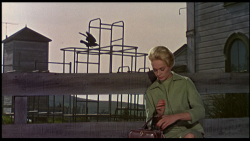
Hitchcock knows by now that, if he’s done his job properly, then the very sight of a bird will be enough to make us jumpy, uneasy, particularly as, like Mrs Danvers in Rebecca, they seem to have the capacity to creep up on you unaware. So, as Melanie sits down and lights a cigarette, one bird lands on the climbing frame, behind her and immediately hops over, as if expecting company (a brilliant eerie detail). Again classic suspense technique: the audience now knows more than the character and feels anxious on her behalf and powerless to warn her: when/how will she find out? And how will she react? And while we’re taking that in, Hitchcock cuts to a slightly wider angle, allowing us to see that, in the space of a few seconds, a few more birds have arrived silently, adding to our apprehension. Then, in a particularly telling moment, Hitchcock keeps the camera on Melanie, so we cannot see and have to imagine what is happening behind her, and the suspense now comes not from what the director shows but from what he withholds. She smokes anxiously; the nursery-rhyme seems endless.
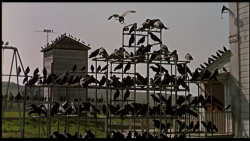
And then Melanie notices something and looks up: a solitary bird is flying across the sky, usually a harmless enough sight, but not here. She follows its flight, the moment being stretched as her nerves are being stretched, until its descent; and she turns to see (and Hitchcock, in planning the scene, felt he could hear an audible gasp from the audience at this point) the climbing frame which is now full of birds. Whilst she has been finishing her cigarette, gathering behind her has been her worst nightmare. Tippi Hedren’s reaction is marvellous; a silent scream, for she dare not make a noise for fear it will set them off. The image is like something out of Edvard Munch.
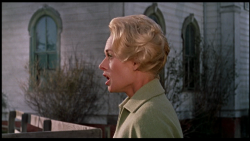
The shock comes from the speed and silence with which the birds have gathered, but it comes from something else as well, which Hitchcock and his writer Evan Hunter might have picked up from the original story: the irrational sense of an implied intelligence and intention behind the birds’ behaviour. After all, why don’t they attack Melanie? It’s almost as if they’re saying: we’ll get to you later (which they do). At that moment that doesn’t seem part of their plan, they’re waiting for the children; and somehow seem to know what time school is out. There’s an intriguing shot just before the children run from the school, when Hitchcock cuts to a shot of the birds; it looks almost as if they’re chatting amongst themselves. Then we hear the sound of running; the birds fly out in a mass at the camera; and in long shot we see the blue sky seeming to turn black as the birds swoop down on their young prey.
Why do the birds attack? The film has been sometimes criticised for offering no definitive answer to this question. Hitchcock was accused of being pretentious and trying to imitate the ambiguities and complexities of European art cinema; but he was simply being true to the original story, for Daphne du Maurier doesn’t offer any explanation either. He always said the theme of the film was complacency, and an attack on human complacency; and to have provided a comfortable explanation at the end for what had happened would have undermined his whole strategy. I’ve sometimes felt that both he and du Maurier were picking up on a kind of post-war anxiety about threats from the air: in du Maurier, an imaginative response to a post-World War Two environment in which humanity is still coming to terms with the dropping of the atom bomb and the realisation that, for the first time in the world’s history, war can become synonymous with global annihilation; in Hitchcock, a similar response to a Cold War environment in which humanity, in the Cuban missile crisis of the year before, had been taken to the brink of nuclear devastation. Both are apocalyptic, end-of-the-world scenarios for an era that seemed bent on self-destruction.
Inevitably the film has prompted many different interpretations: maybe the birds are an enactment of the caged passions the humans are trying to conceal- hostility, jealousy, rage … or: more generally and symbolically, the birds represent the forces of chaos, or natural disaster, that can erupt with shocking suddenness into people’s lives and turn their values upside down, forcing them to re-evaluate their priorities.
One of the questions that the film raises is: is the heroine, Melanie Daniels, the cause of it all? The attacks only start when she arrives in Bodega Bay. Her ‘teasing’ of the other characters (Mitch, his mother, the schoolteacher Annie) unleashes a chaos of human emotion that has previously been caged or contained: the mother’s possessiveness and her terror at being left alone; Annie’s unrequited love for Mitch. There’s also a curious sub-text of family dysfunctionality, where Mitch has a possessive mother and absent father whose portrait is still prominent in the house; Melanie is close to her father but reveals she’s been abandoned by her mother when she was 11, which might be why she’s drawn to Mitch’s younger sister Cathy (Veronica Cartwright) who’s also 11. There’s this tangled knot of interconnecting relationships, with emotions swirling between passion, possessiveness, jealousy, anger, and which are going nowhere until the bird attacks force the characters to rip apart the evasions and face the fears that confront them.
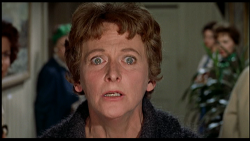
Yet when Melanie is accused of being the cause of it all by a hysterical woman in the café, the woman is looking straight into the camera and thus directly at us, the audience. ‘They say when you came, the whole thing started,’ she says: well, that’s certainly true, the film couldn’t start without the audience. ‘I think you’re the cause of all this,’ she goes on, ‘I think you’re evil, EVIL!’ Is it, then, an accusation implicitly directed at all of us: a sort of Day of Judgment, an ecological horror story in which Nature strikes back in vengeance at the violations of Nature by mankind? The film incidentally has sometimes been seen as more analogous to a poem than to a short story. It works through rhythm and intensity of imagery rather than through narrative coherence and rounded characters, and is comparable particularly to a poem like Coleridge’s The Ancient Mariner, another Revenge of Nature tale against man’s heedless inhumanity.
OR: another reading of that line, spoken directly at the camera, ‘I think you’re the cause of all this, I think you’re evil’: is it, like a number of Hitchcock’s films, and particularly a film likeRear Window (1954), in some regards about the film audience, where very often the structure seems to encourage an audience to indulge its impure emotions (when I sawThe Birds for the first time, someone behind me in the audience was getting very impatient with the film’s slow opening, and murmuring, ‘When are the birds going to attack, when are the birds going to attack?’) and then being compelled to live through the consequences of these emotions- i.e. when they’re turned back on you and you’re terrified. This could be the reason that Hitchcock’s films have such cathartic power and which one could say is the moral imperative behind his use of suspense. Robin Wood has particularly examined this aspect of Hitchcock’s use of suspense and its therapeutic effect and value.
OR: more specifically, when that hysterical character says, ‘I think you’re the cause of all this’ directly at the camera, she is, in a literal sense, absolutely right: the camera is the cause of all this. This would take us back to the basic premise of Hitchcock’s work as a film director: namely, that the camera tells the story, not the dialogue, not the characters, but the camera. I think that one of the things that most appealed to him about The Birds as basic material- and I’m not sure it would have occurred or appealed to Daphne du Maurier, or any writer for that matter- is that on one level it’s about the futility of language. Words are of little use in the film and often evasive and misleading; indeed, in the early part of the film the characters spend an inordinate amount of time verbally sparring with each other in increasingly frustrating games of ego and undisclosed desire (as Robin Wood once speculated: what would have happened to these people and these relationships if the birds hadn’t attacked?). There’s a scene in a café which must be one of the longest dialogue scenes in the whole of Hitchcock where a crisis debate about why this is happening and what to do about it leads absolutely nowhere, at which point the birds attack, and reduce them all to silence anyway. Critics have tried to rationalise the film, or attacked it for being irrational- but it’s not an illogical film, it’s an anti-logic film that undercuts humanity’s sense of rational superiority. ‘There are more things in heaven and earth than are dreamt of in your philosophy’, as Hamlet says to Horatio (and even Annie asks Melanie at one stage: ‘what do you think of our little hamlet?’) Film should be stronger than reason, Hitchcock thought, and the fact that this film’s basic premise- Birds attack people- is fantastical is precisely the point. The basic premise was the thing that François Truffaut admired above all about it. ‘I am convinced that the cinema was invented so that such a film could be made,’ he said.
Daphne du Maurier was understandably miffed that Hitchcock continued to get credit for an idea that was originally hers; and she certainly didn’t like the liberties he took with the setting and the characterisation. And yet it does intrigue me that, in two widely different adaptations of du Maurier’s work- one intentionally faithful to the text, the other flying off in its own direction- Hitchcock reveals in both something absolutely fundamental about himself and about his cinema. With Rebecca we get the unexpected revelation of a romantic yearning in Hitchcock which was hitherto unsuspected and which will come to the fore in some of the greatest of his later works; and also an empathy for feminine feeling which is also new in his work and which critics have argued anticipates his later exploration of ‘feminine’ regions of his own personality- the sensitivity, the passivity, the anger. With The Birds, we get Hitchcock the ultimate cineaste, a film which as much as any other demonstrates film’s difference from literature; almost his revenge on a literature-dominated film culture in the form of a film adaptation that words cannot ultimately explain. ‘I don’t care about the subject-matter;’ he told Truffaut, ‘I don’t care about the acting; but I do care about the pieces of film and the photography and the soundtrack and all the technical ingredients that make an audience scream. It’s tremendously satisfying to able to use the cinematic art to achieve something of a mass emotion, where audiences are not stirred by the message, or great performances, or enjoyment of the original novel, but by pure film.’ By imagining and creating source material that penetrated to the roots of a great film-maker’s personality and his technique, Daphne du Maurier will always have a special place in the heart of all lovers of the films of Alfred Hitchcock.
Neil Sinyard
This is the text of a public lecture at the Daphne Du Maurier Festival in May 2012.



No comments:
Post a Comment